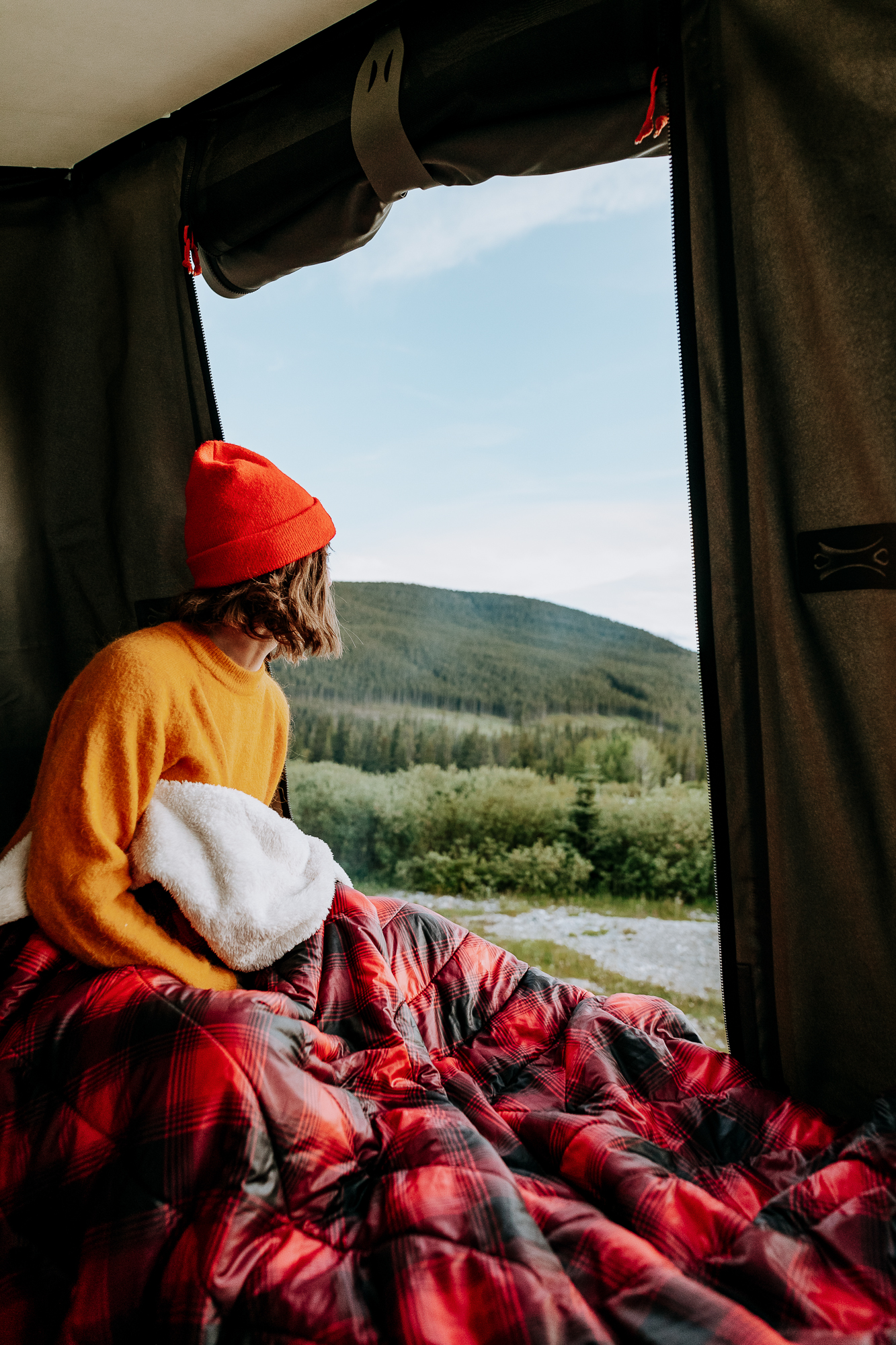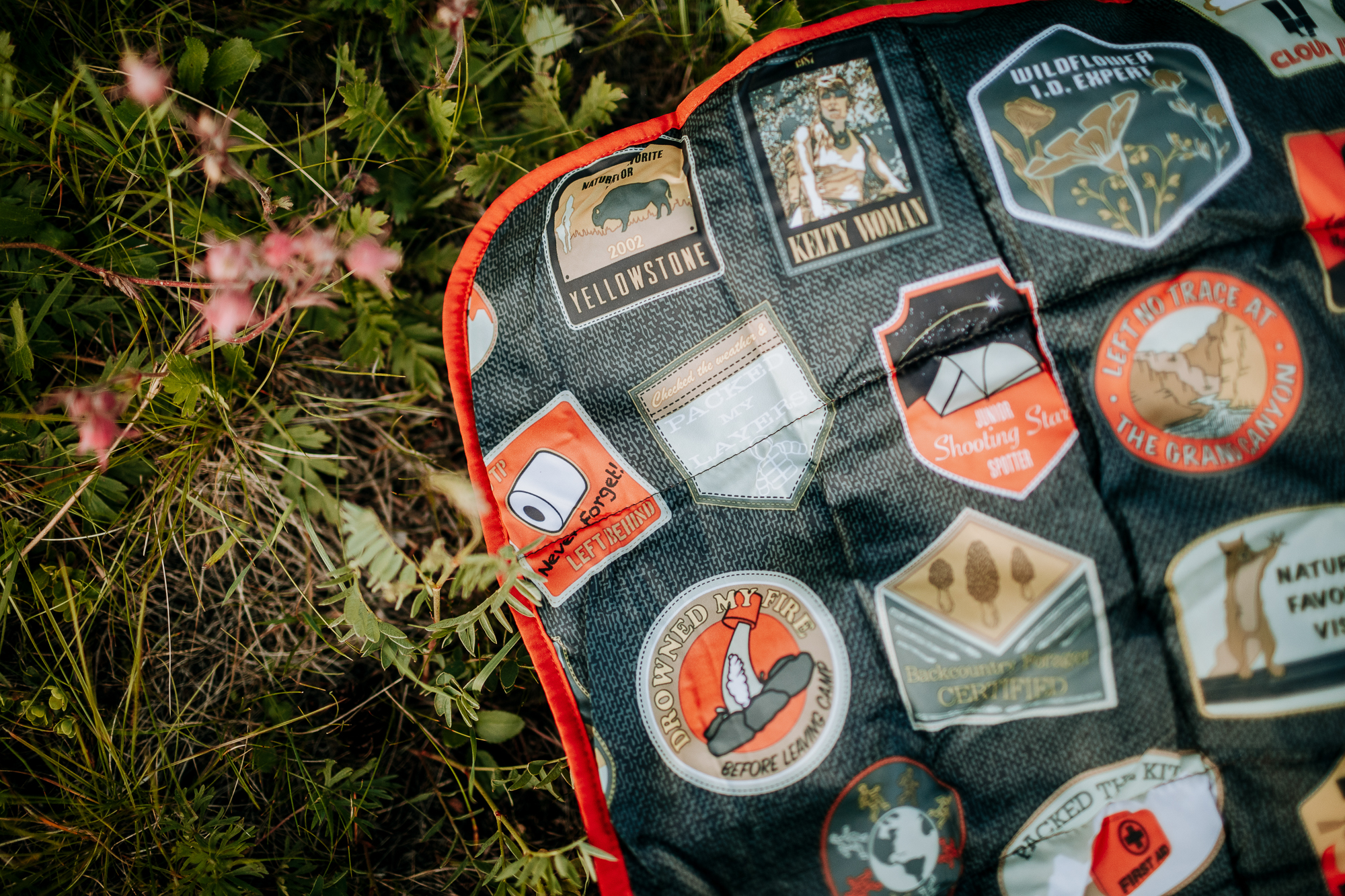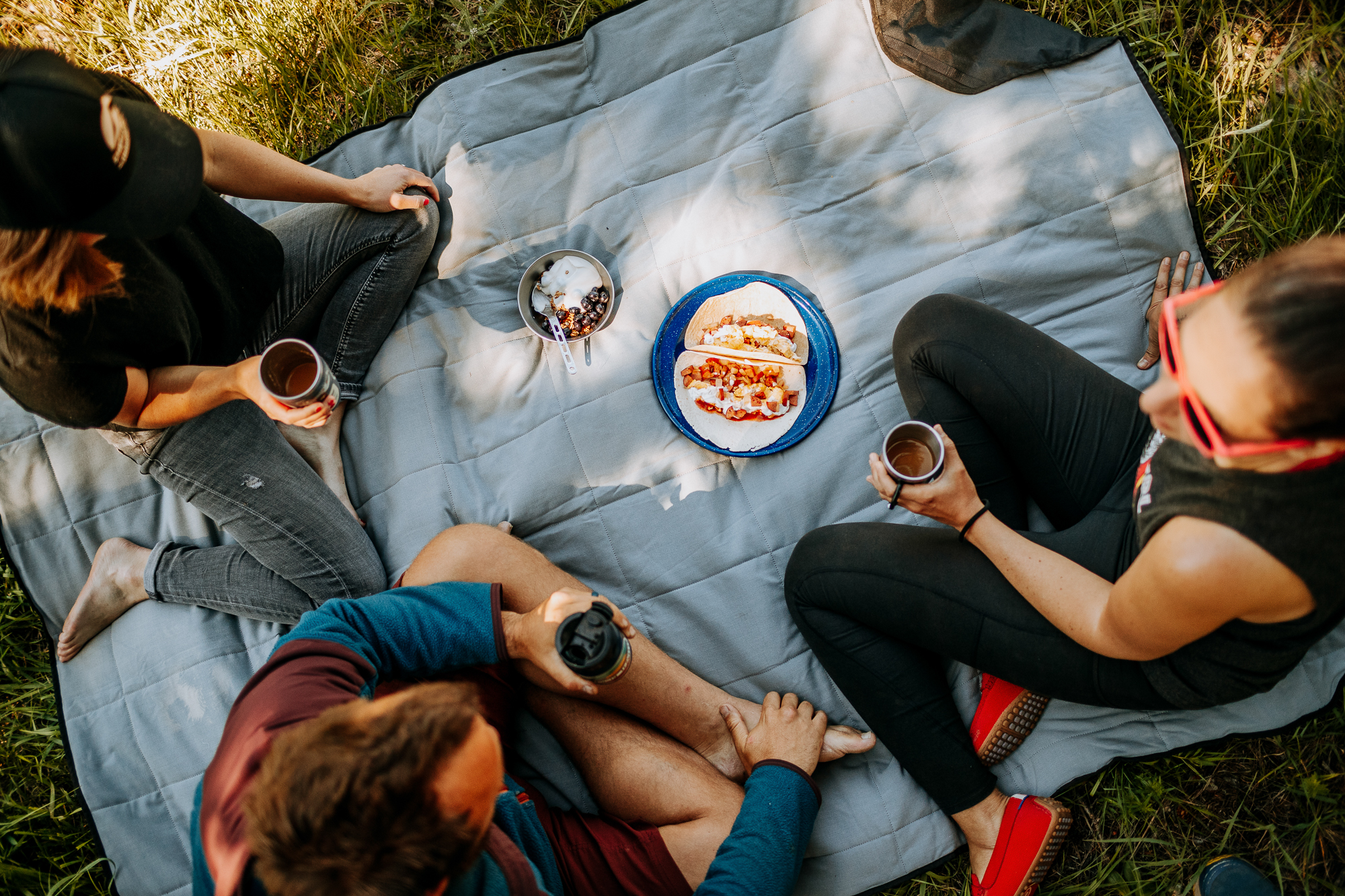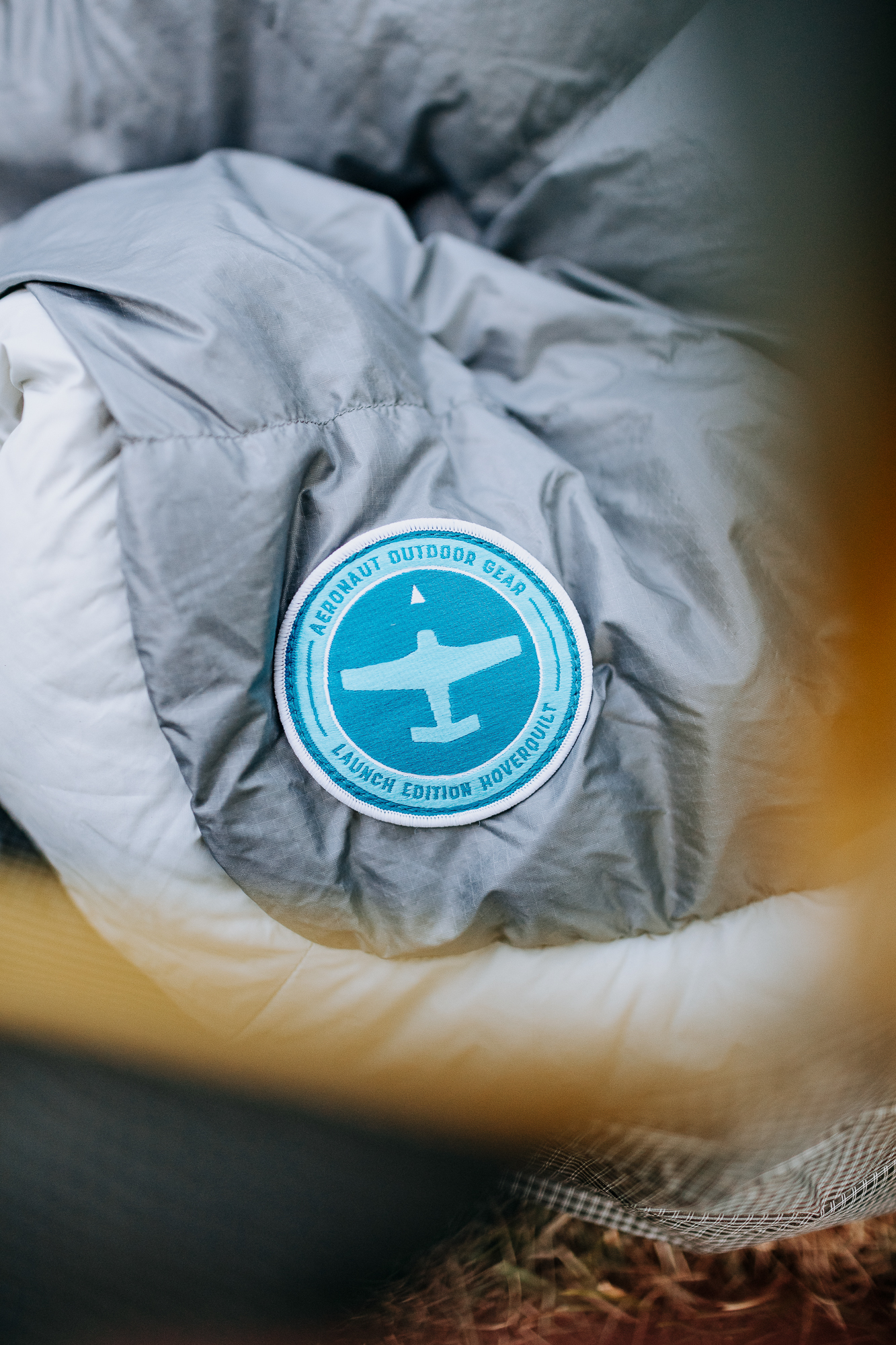Photography by Richard Giordano
Editor’s Note: This article was originally published in Overland Journal’s Gear 2023 Issue.
When Chief Three Eagles, leader of the Salish peoples, first encountered the Lewis and Clark Expedition party in the wide valley of Ross’ Hole, Montana, in 1805, he was baffled. The men weren’t wearing any blankets. Had they been robbed? “Bring the best buffalo skins,” he is said to have requested, “one for each man to sit on. Bring the best buffalo robes, and put them over the men’s shoulders.” Although the men involved in the Lewis and Clark Expedition did carry blankets (packed away in their bags), the team only used them for sleeping. But this cultural exchange broke the ice between the two parties, and it wasn’t the first time (or the last) that a blanket would be used for more than physical warmth.
We tuck ourselves into bed each night, snuggling underneath this seemingly simple and omnipresent item. Whether a linen sheet, down duvet, or wool varietal, these comfortable coverings have been the fabric of our lives for much of human existence. Ancient Egyptians used linen bed sheets, while wool blankets graced the beds of the Roman Empire. Wealthy Vikings used cotton and silk sheets with feather duvets, and animal hides such as sheepskin were a feature of longhouse beds. In North America, blankets played a role in trade long before the wool covering was issued to military forces in the 18th and 19th centuries. Today, there are numerous choices depending on where in the world we live.
When it comes to camping and overlanding, I’ve typically stuck to a duvet or my trusty Marmot sleeping bag. An extra blanket can seem like an unnecessary luxury when space is limited or you’re on a tight budget. But camp blankets also bring a feeling of home to your setup and can come in handy on chilly nights. I’ve also discovered a wide variety of camp blankets that really shine for different purposes, such as enjoying a crackling campfire, cozying up in a van or truck camper, or sharing a picnic in the grass with friends.
If you’re in the market for a camp blanket, consider its purpose. How will you use it? Does it need to be multi-functional? Additional factors include size (will you be sharing the blanket?), packability, durability, and materials. Down blankets pack well and are lightweight, while synthetic options are generally less packable but can stand more abuse. Wool retains warmth while wet but can be heavy and scratchy. Perhaps a heavy blanket is a plus—studies show that weighted blankets can help reduce both anxiety and nighttime levels of the stress hormone cortisol. Do you require a durable water repellent (DWR) coating, or will the blanket live most of its life indoors? Finally, some blankets are not easily washable, which can be an inconvenience for some. I’ve whittled my top choices down to help narrow your search, no matter what you’re looking for. (AG)
Wool: Alpaca Threadz Andean Alpaca Wool Blanket

Forced to put their travel company on hold in 2020, LeAnn and Brandon Morris were looking for another way to support local artisans during the global pandemic. Textiles are an important facet of Andean culture, so LeAnn and Brandon began working with local artists to create Alpaca Threadz, a fair-trade company seeking to support communities in remote Ecuador and Peru. An additional 10 percent of profits go back to local families to set “a trajectory of growth.”
My initial reaction to the Alpaca Threadz camp blanket was that it was so lovely I didn’t want to bring it outside. Made of 50 percent alpaca wool and 50 percent acrylic material with recycled content, this queen-size blanket feels as soft as cashmere and features a reversible Mojave design. At 7.5 by 6.5 feet, it’s perfect for two people and is hypoallergenic, lightweight for its size, and large enough to share. Rather than dragging it through the dirt (although I’m sure it would hold up), this blanket’s best life is in a van, truck camper, trailer, or lazily tossed on a bed in a rustic cabin.
I used this camp blanket during frosty nights in our Go Fast camper near Bryce Canyon and at a few overland rally events. This is not a throw I would allow a pet dog to squat on—it’s too stylish, comfy, and special. However, there wasn’t a blanket I enjoyed more while sipping my morning coffee at the dinette table or pulling up to my chin at night. Cleaning instructions are simple: dry clean, handwash, or use the machine on gentle. Tumble dry on low or air dry. (AG)
$150 | alpacathreadz.com
Fleece: Rumpl Sherpa Puffy Blanket


Rumpl founders Wylie Robinson and Nick Polinko were on a surf and ski trip in California when they found themselves without cell reception and in a car that wouldn’t start. While wrapped in sleeping bags to keep warm, inspiration struck the duo, and the “sleeping bag blanket” was born. Today, Rumpl’s synthetic insulation is made from recycled plastic bottles; they are a member of 1% For The Planet and are Climate Neutral and B Corporation certified.
Out of the blankets tested, I grabbed the 2.9-pound Rumpl Sherpa Puffy Blanket most often for out-of-truck pursuits. During overland rally raffles, lugging my camp chair somewhere, or heading to a bonfire with friends, the Sherpa’s small size (roughly 4 by 6 feet) and use of the Cape Clip or carrying straps made it the most convenient to tote around. The blanket combines the best of both worlds: high-pile sherpa fleece on one side and an insulated DWR-finished 100 percent post-consumer recycled polyester shell on the other. I tested the two-person Ombre Plaid blanket, but it also comes in Junior and two-person sizes.
I was very satisfied with the quality of this blanket and felt confident in the stitching, materials, and construction. Plus, one of my favorite qualities is that it is so warm. I get cold easily, and the Sherpa kept the chill off during crisp Spring evenings in the Rockies and acted as a comforting and effective second layer in bed. The Sherpa Puffy is machine washable. (AG)
$169 | rumpl.com
For the Kids: Kelty Bestie Blanket


Founded in 1952, camping supply company Kelty made a splash with conifer-colored packs used during undertakings such as the American Everest Expedition of 1963. The brand has since expanded, constructing a variety of backpacking, camping, and sleep solutions. Kelty is one of the founding members of The Conservation Alliance, which prioritizes conservation efforts in the outdoor industry.
The Bestie blanket’s name resonates for a good reason. It encompasses everything one seeks in a quality best friend: reliability and trustworthiness with a splash of fun. This classic camp blanket is simple, packable, soft, and comfortable. The Cloudloft insulation provides a satisfying amount of warmth for how lightweight the throw is (1.54 pounds), and the shell, made from 75D printed polyester taffeta, is pleasing to the touch. A stuff sack is included for easy transport.
Due to its 6- by 3.5-foot size, availability of fun prints (mine is a lively mix of “rooibos tea” and scout-inspired patches), and durability, this blanket is great for kids. Throwing it onto a sandy beach, a grassy knoll, or letting your pup trample over it isn’t a big deal. Most of all, the Bestie provides great value for the price point, so if the kiddos bicker over it, there’s likely room in the pocketbook for several. Perhaps it isn’t the smallest while packed or the most technical, but it’s a solid choice, comes with a lifetime warranty, and is machine washable. (AG)
$30 | kelty.com
Heavy-Duty: Dometic Go Camp Blanket

The Dometic Go Collection is specifically designed for vehicle-based adventure pursuits, and its camp blanket is no exception. Weighing 4 pounds and spanning 6.5 by 4.5 feet while flat, this is the largest and heaviest blanket of the bunch, even when folded away in a stuff sack. If you are budgeting in the space and weight departments, a smaller, lighter blanket would be a better fit; that said, for those with ample room, Dometic’s camp blanket is rugged and features a padded top, waterproof bottom, and small loops in each corner if users wish to hang it up as a tarp.
I found this blanket quite comforting while sitting by the fire, the water-resistant, tough polyester and rayon blend top felt nice against the skin, and the hefty 600D polyester and polyurethane bottom provided substantial protection. Designed for use as a picnic or personal blanket or as a weather shelter, Dometic suggests the blanket can also be used as an additional insulation for your tent floor. Sized for one small person, the Go Camp Blanket offers a limited three-year warranty and can be machine washed and dried. If you have the space, I think this throw is well-suited for rocky, dirty, or sandy ground, as a place for your dog to chillax, or as a heavy-duty top layer for sub-zero nights. (AG)
$140 | dometic.com
Lightweight Down: Aeronaut Hoverquilt


You might wonder how a down blanket could ever replace your trusty sleeping bag. I pondered this myself before testing the Aeronaut Hoverquilt. Down blanket proponents point to their lightweight qualities and better movement and temperature regulation while sleeping. Featuring 750 fill power goose down, a soft 20D ripstop nylon shell, and a taffeta weave nylon liner, the Hoverquilt measures 90 inches long by 80 inches wide and weighs around 2.5 pounds. The size nearly equals a double (full), which explains why it feels more like your blanket at home than your typical mummy bag. Although the Hoverquilt is advertised as being comfortable to 30°F, the company argues it is, in reality, comparable to a 15°F rated sleeping bag (the rating references comfort rather than the bag’s lower, or survival, limit).
One detriment to a lightweight, slightly slippery blanket is the tendency for your partner (aka the blanket thief) to snatch away your much-coveted covers. Fortunately, Aeronaut offers Aerostraps, which connect blanket loops with your mattress for ultimate heat retention. If you are flying solo, the blanket can be folded, burrito-style, for optimal warmth.
At a price point that could buy you a pair of 15°F sleeping bags, it’s up to you and your camping style to decide if two bags (that you could also use while backpacking) or a cozy, luxurious blanket (perfect for a camper or rooftop tent) is the best option for you.
Aeronaut offers a 100 percent guarantee that instills confidence: if you’re not 110 percent happy within 110 nights, the company will honor a full refund, including return shipping.
$499 | aeronautoutdoor.com
Synthetic Down: Rumpl Nanoloft Flame

Camp puffies have numerous benefits, like reduced weight and improved insulation, but technical fabrics like polyester will melt quickly from even the most benign ember. Rumpl has now addressed fireside issues with the new NanoLoft Flame.
Impressively, the Flame weighs only a pound and packs in less volume than a 1,000-milliliter Nalgene bottle. The fire-resistant topside is made from 60 percent modacrylic and 40 percent cotton. Modacrylic provides protection from electrical arcs, most acids, moths, mildew, and UV rays; it will not wrinkle and feels soft to the touch. When tightly woven with cotton, it also has natural water resistance, further improved by the durable water repellant (DWR) finish and, most importantly, flame retardancy. The back side of the blanket is 100 percent polyester (likely a cost savings); it would be less prone to sliding off the wearer if both surfaces were modacrylic/cotton. The filling is 100 percent polyester NanoLoft, which mimics the characteristics of down, yet better survives wet conditions and repeated compressed storage.
The Flame is one of the best travel blankets I have used, serving many needs while being warmer than expected. My challenges were few, focused mainly on the 38 x 52-inch travel size, which felt more like a loincloth than a comforter. The cape clip also needs a loop on the long side. Modacrylic requires careful handling, as even one trip through a hot wash cycle or dryer could ruin it forever. (SB)
$129 | rumpl.com
Our No Compromise Clause: We carefully screen all contributors to ensure they are independent and impartial. We never have and never will accept advertorial, and we do not allow advertising to influence our product or destination reviews.
Read more:


